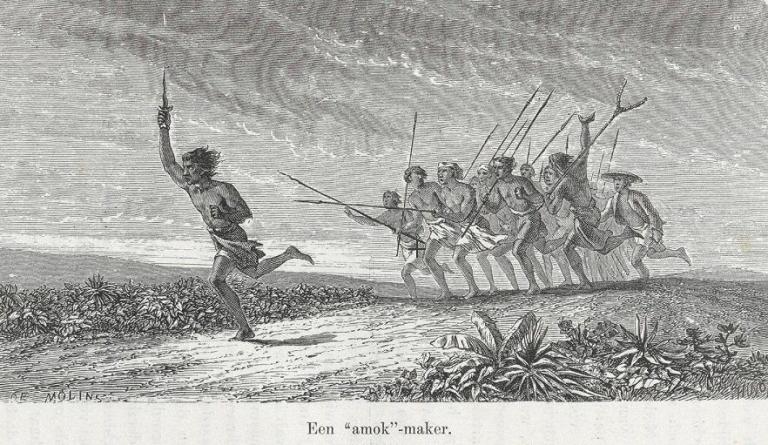An iconographic and text archive related to communication, technology and art.
“… No, wait. Perhaps I can make you understand it after all. Do you know what the expression ‘running amok’ means?”
“‘Running amok?’ Yes, I think I do… a kind of intoxication affecting the Malays…”
“It’s more than intoxication… it’s madness, a sort of human rabies, an attack of murderous, pointless monomania that bears no comparison with ordinary alcohol poisoning. I’ve studied several cases myself during my time in the East —it’s easy to be very wise and objective about other people—but I was never able to uncover the terrible secret of its origin. It may have something to do with the climate, the surly, oppressive atmosphere that weighs on the nervous system like a storm until it suddenly breaks… well then, this is how it goes: a Malay, an ordinary, good-natured man, sits drinking his brew, impassive, indifferent, apathetic… just as I was sitting in my room… when suddenly he leaps to his feet, snatches his dagger and runs out into the street, going straight ahead of him, always straight ahead, with no idea of any destination. With his kris he strikes down anything that crosses his path, man or beast, and this murderous frenzy makes him even more deranged. He froths at the mouth as he runs, he howls like a lunatic… but he still runs and runs and runs, he doesn’t look right, he doesn’t look left, he just runs on screaming shrilly, brandishing his bloodstained kris as he forges straight ahead in that dreadful way. The people of the villages know that no power can halt a man running amok, so they shout warnings ahead when they see him coming—‘Amok! Amok!’—and everyone flees… but he runs on without hearing, without seeing, striking down anything he meets… until he is either shot dead like a mad dog or collapses of his own accord, still frothing at the mouth…”
☛ Amok by Stefan Sweig, trans. Anthea Bell, London: Pushkin Press, [1922] 2008, pp. 47-48. See below for a French translation of the same quote.
This post was updated on March 12, 2021, to add information and references.. To learn more about “amokers” one can watch the short, 4-min video below, featuring Prof. Geoffrey Robinson who teaches Southeast Asian history and politics at the University of California, Los Angeles. An introduction to the video (coproduced by The New York Times and RetroReport.org) is available at The New York Times: “From 200 Years Ago, a Lesson About Mass Killings” (Clyde Haberman, Dec. 10, 2017). Transcript from the video is available at RetroReport.org.
For additional information, see the monograph Running Amok. An Historical Inquiry by John C. Spores (Ohio University Press, 1988), as well a a useful review of it by Tan Eng Seong. On his research blog, Jonathan Saha offers a critical take of the phenomena from the perspective of colonialism: “Amok in Malaya, Murder in Burma” (May 20, 2014).
The same excerpt, in French translation:
– D’ailleurs, attendez… peut-être, malgré tout, pourrais-je encore vous faire comprendre… Savez-vous ce que c’est que l’amok?
– Amok?… Je crois me souvenir… c’est une espèce d’ivresse chez les Malais.
– C’est plus que de l’ivresse… c’est de la folie, une sorte de rage humaine, littéralement parlant… une crise de monomanie meurtrière et insensée, à laquelle aucune intoxication alcoolique ne peut se comparer. Moi-même, au cours de mon séjour là-bas, j’ai étudié quelques cas – lorsqu’il s’agit des autres on est toujours perspicace et très positif – mais sans que j’aie pu jamais découvrir l’effrayant secret de leur origine… La cause en est, sans doute, le climat, cette atmosphère dense et étouffante qui oppresse les nerfs comme un orage, jusqu’à ce qu’ils finissent par éclater… Donc l’amok… oui, l’amok, voici ce que c’est: un Malais, n’importe quel brave homme plein de douceur, est en train de boire paisiblement son breuvage… il est là, apathiquement assis, indifférent et sans énergie… tout comme j’étais assis dans ma chambre… et soudain il bondit, saisit son poignard et se précipite dans la rue… il court droit devant lui, toujours devant lui, sans savoir où… Ce qui passe sur son chemin, homme ou animal, il l’abat avec son kriss, et l’odeur du sang le rend encore plus violent… Tandis qu’il court, la bave lui vient aux lèvres, il hurle comme un possédé… mais il court toujours, sans rien voir de ce qu’il y a à sa droite ni à sa gauche, courant toujours en poussant son cri perçant et tenant à la main, dans cette course épouvantable, son kriss ensanglanté… Les gens des villages savent qu’aucune puissance au monde ne peut arrêter celui qui est en proie à cette crise de folie sanguinaire… et, quand ils le voient venir, ils vocifèrent, du plus loin qu’ils peuvent, le sinistre avertissement: “Amok! Amok!” et tous s’enfuient… Mais lui, sans entendre, poursuit sa course; il court sans rien voir et continue de tuer tout ce qu’il rencontre… jusqu’à ce qu’on l’abatte comme un chien enragé ou qu’il s’affaisse anéanti et tout écumant… (ZWEIG, Stefan ([1922] 2002). Amok, tr. A. Hella et O. Bournac, éd. Stock, coll. Bibliothèque Cosmopolite, Paris, pp. 70-71)
The image below comes from Le Tour du Monde, vol. 10, Paris (Hachette) 1864, p. 263.

- By Philippe Theophanidis
- on
- ― Published in Art, Communication
- Tagged: amok, amoklaufer, colonialism, death, Literature, Lost, madness, maniac, mass murder, Zweig
